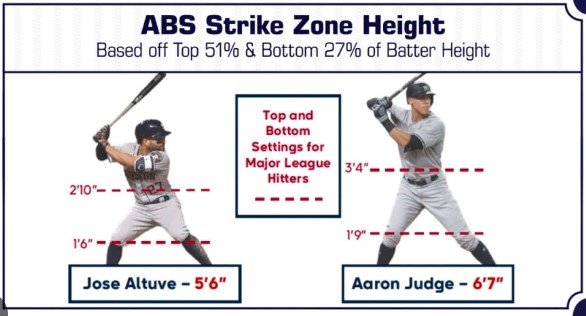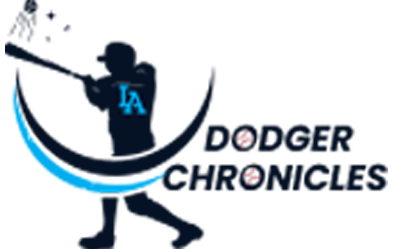
Of course we do, but in a limited basis. I am in favor of the challenge system with ABS technology vs full out Robo Umps. The game is played by human and should be monitored by humans, with the limited ability to challenge human calls.
Batters swing and miss, pitchers throw WP and HBP and balk, catchers get PB and catcher’s interference, and fielder’s still make errors. Umpires blow calls. It is part of the game.
Yes, I know mistakes by the players are supposed to impact the game, but not umpire decisions. And yet they can and sometimes do.
But technology can adjust that outcome. An ABS system called Hawk-Eye possesses the capability to make correct calls on balls and strikes.
“Its job,” Hawk-Eye founder Paul Hawkins said, “is to let the sport do the talking and keep the officiant out of it.
Of course it is better to get the call correct, but at what expense? MLB was the last of the four major professional sports to utilize instant replay to assist in making the correct call. The technology has improved immensely since initiated and promises to get even better as time moves on.
The most egregious call by an umpire came in the bottom of the 9th of Game 6 of the 1985 World Series. Don Denkinger absolutely blew an out call at 1B when he called Jorge Orta safe on a play where he was clearly out. There cannot be any more important of a time to get the correct call than in that situation. Replay could have reversed the call and the WS MIGHT have had a different result. Okay, more than probable. But there was no replay at the time.
When researching information for this, I came across an SI article on The Call, and the impact on Don Denkinger. I found it to be a fantastic read.
https://www.si.com/longform/2015/1985/world-series-cardinals-royals/index.html
It was not until August 28, 2008, when MLB made instant replay a part of the game. It was first used at Tropicana Field on September 3, 2008. Alex Rodriguez hit a ball near the left-field foul pole that was initially ruled a home run by third base umpire Brian Runge. Tampa Bay Rays manager Joe Maddon and catcher Dioner Navarro argued that the ball was foul and asked for a review. After a conversation among the umpires, crew chief Charlie Reliford allowed the replay to take place and after review, upheld the home run call.
The first overturned call also occurred at Tropicana field on September 19. in the bottom of the 4th inning with two runners on base, Carlos Peña of the Rays hit the ball just over the fence in right field. The umpires originally ruled that there was spectator interference, but after several minutes of viewing replays, the umpires returned to the field and signaled it a home run, extending the Rays’ lead to 9-0.
Replay was used 123 times between August 28, 2008, and the conclusion of the 2010 season (with 48 of those instances resulting in overturned calls).
But replay reviews have to be used judiciously. Each team gets to challenge one call per game. If the challenge is overturned, the challenging team gets to keep their challenge. If the challenge is upheld, the challenging team loses the opportunity for any future challenges in that game.
The same ideology is used in the MiLB ABS challenge system. Each team is allotted 3 balls/strikes challenges.
But what about the technology?
This is a UK based technology developed by Paul Hawkins, a British Ph.D. student in Artificial Intelligence, looking for a way to review cricket calls. Hawkins was a semi-pro cricket player and had a bad call go against him. He set out to develop a system to show the correct call. His technology is referred to as the Hawk-Eye System.
After its design, USTA (United States Tennis Association) would use it for television to show whether the line judge or chair umpire got the call correct. It became a huge controversy in the 2004 US Open Quarterfinals between Jennifer Capriati and Serena Williams.
On that September night in 2004, onlookers at the National Tennis Center were baffled as Williams, in the decisive third set of a loss to Jennifer Capriati, was the victim of four questionable calls, or flat out mistakes by the line judges and chair umpire. One ruling on a ball well inside the line was so egregiously incorrect that Williams received a call of apology the next day from USTA president Arlen Kantarian.
“Hawk-Eye please,” commentator John McEnroe said at one point during the match. “This is getting ridiculous.”
Hawk-Eye is now used in 3 of the 4 USTA Grand Slam events. Only the French Open chooses to not rely on Hawk-Eye because of clay courts. It is not deemed necessary because when the ball bounces on the surface, it leaves behind a mark thereby eliminating the need for an electronic line-calling system. Or so they say.
There are two systems under review and both have been implemented in MiLB. “Full ABS” is what many refer to as “robot umps” — a system in which the home-plate umpires are not making ball-strike decisions on their own, but rather, immediately relaying the Hawk-Eye system’s determination of ball or strike, which they receive via an earpiece.
The alternative is a system developed in USTA for disputed line calls. If the player disputes a line call, the player can challenge, and the Hawk-Eye System will provide a clear indication as to whether the ball was in or out. A player only gets a limited number of challenges. If the challenger is correct with the challenge, they retain their challenges.
In MiLB, umpires make the ball-and-strike calls, and pitchers, catchers and batters have the ability to make an appeal to the ABS system. ONLY pitchers, catchers, and batters can challenge. It cannot come from the bench or another fielder.
As for the human umpiring element, for generations, 0-2 pitches in blowout games haven’t necessarily been called the same as 0-2 pitches in one-run games in the bottom of the ninth. Argue with that, if you will, but that is the culture that baseball people are accustomed to. So a fixed, unimpeachable and dispassionate standard set by a computer would make for a major adjustment.
In a challenge system, if it’s a close called strike, does the batter challenge? If it’s a close called ball, does the pitcher or catcher challenge?
At last check, in 2022, players in Minor League games using the challenge system were successful on about 44% of challenges.
Pitchers and catchers (46%) have fared a little bit better than batters (42%) when challenging.
Is Hawk-Eye reliable enough to implement in MLB? Hawk-Eye’s technology is fully embedded in the culture of MLB as it has become the backbone of Statcast’s pitch,- hit- and player-tracking in 2020. The technology has evolved enough to merit more serious consideration soon, perhaps as early as 2024.
“I can assure baseball fans,” Hawkins said, “that having been involved in 25 different sports, MLB has been very thorough in their research and analysis of what is the best way of doing it.”
The challenge system also retains most of the value of pitch framing — a skill that has been a focal point of catcher development and acquisitions in recent years. While not a tool that I particularly care for, it is revered by MLB organizations. It is unlikely to go away.
Hawk-Eye technology is an integral part of tennis, soccer, volleyball, rugby, cricket, badminton and other sports.
Is it foolproof? Nothing is foolproof, as we learned a few weeks back when two bad calls were challenged by both teams, and neither of the umpire’s bad call were not over-ruled by the review team in NY. The calls were blatantly wrong.
I know that umpire calls are infuriating. I am constantly looking at how poorly umpires calls were the previous game by reviewing the Umpires Scorecard the next day. But if a team goes 1-14 WRISP, does a bad umpire call cause the loss?
What I find most reprehensible is that there are no consequences for consistent poor officiating. As Ke’Bryan Hayes recently wrote:
https://x.com/KeBryanHayes/status/1700977560782520397?s=20
In addition to technology, there needs to be consequences for poor umpiring. Just like players can be optioned, waived, DFA’d for poor play, or managers and coaches can be fired for poor decisions, umpires should be held accountable in some fashion.
We know technology can overturn bad balls and strikes calls. Full ABS may not be agreeable to all parties, but a challenge system seems to be a good option moving forward.
If used judiciously as in the 9th inning of Game 6 of the WS, at least there is a much better chance at getting strike 3 call correct.













Will it be more accurate vs will it be perfect.
It will never be perfect.
This post is above my pay grade.
Badger made a great point to me yesterday about job loss.
I come here today to thank him for it.
I quit because of it.
Wouldn’t something like this make the games longer?
Can you imagine how many balls and strike calls will be challenged during a 9 inning game?
A team is limited to 3 a game, and the verification is almost instantaneous. I have watched it work very well at AAA this year. It did not add to the time of the game. The instant replay challenges take up much more time.
Correct, the strike/ball call takes 2-3 seconds. It’s done very well in the minors.
Unless the strike as defined by the rule book has changed, and that’s of course possible, the above graphic is wrong:
The Official Baseball Rules define the strike zone as “that area over home plate the upper limit of which is a horizontal line at the midpoint between the top of the shoulders and the top of the uniform pants, and the lower level is a line at the hollow beneath the kneecap.
Add to that “when the batter is in his hitting position”
It’s my opinion getting the call right is far more important than how many minutes it might take to review. And it shouldn’t take long. And I don’t think going to New York is necessary. Have a 5th umpire in each park looking at the same camera angles we see. There’s a job added Bluto. And ABS removes the need for a ball strike challenge. Perfect Hawk Eye and implement it. ASAP
Okay, whatever system you might use, you still need competence behind the plate. Sorry, most of these guys wouldn’t know a strike if it hit them in the cojones. Umpires need to be more consistent. You never see teams yelling when the umps K zone stays consistent. But when some guy is calling pitches 6 inches outside strikes, or balls almost in the dirt strikes, something needs to change.
Well it is obvious that something needs to change. The home plate umpiring has become unacceptable.
I think that most fans have wanted to argue balls and strikes forever. What’s different now for the viewer at home is that we get Pitchtrak data from watching the little box superimposed on the home plate area on our TVs, so now we think we see the real strike zone and see where the umpires get it “wrong”.
I don’t know how accurate the little box really is. If it’s accurate and instantaneous, we don’t really need a challenge system. They should just have the computer call the balls and strikes. At least that is the theory.
How much does that end up detracting from the game? How much does it add?
As a traditionalist, I have generally been in favor of maintaining the idiosyncratic strike zone that we currently have. But you hate to have a “bad call” change the outcome of a game.
It’s a hard call.
I can see a problem with attempted steals. Even if it takes a couple of seconds to get the correct info to the umpire to make the call, what if it is a potential strike 3 or ball 4. If the runner takes off from 1st, I can see the catcher throwing it down to 2nd when it is actually Ball 4 and the throw goes into CF. Now runners on 1st and 3rd instead of 1st and 2nd. 2.00 second catcher pop time is not very good.
Michael Busch has been named Baseball America’s 2023 MiLB Player of the Year.
Whoa
Big
for the Dodgers? Or all over MILB?
Dodgers. It is hard typing from my phone.
While I read the posts here and know many names from Mark Timmons website, I’ve never posted here before. But the conversation about ABS is to enticing to ignore.
I’ve stated my opinion back ABS before and my opinion of a challenge system. But my point must be flawed as nobody has picked up on it. Maybe I’m missing something. So I will try to explain here why I just want the Hawk-eye, ABS system utilized as soon as possible.
First, I think the technology is there and accurate. It can be adjusted to player’s size and stance. Secondly, I’ve see enough bad balls and strike performances by umpires. We all know who the worst balls and strike guys are and Umpire Scorecard reports on performance. The worst offenders are frequently veterans and crew chiefs. Despite the evidence of incompetency, MLB does nothing about it. Individual reviews are a secret and have no impact on improving the performance of the worst offenders.
Here’s my argument against a challenge system. It puts another strike zone in play in addition to the Umpires personal strike zone. Each Ump has their personal interpretation of the zone. Some very consistent Umps will give the outside strike and pinch the opposite corner. Some give the high strike and not the low one. So the zone that day is a ball off the corner.
But suddenly in a critical situation that zone is challenged. And a totally different zone, the ABS zone, is used to decide strike or ball. I don’t believe that 2 different strike zones should be in play at the same time. One used all day, good or bad, and another used for a challenge.
I think MLB should use the ABS full time. That eliminates all the fuss.
If not then eliminate the little box on the TV and let the HPU call the game with no visual “evidence” to critique his zone. Just like years ago when we saw Sandy drop in that deuce as we lived with the HPU’s call.
To me it’s a no-brainer. Get the calls right. Use the ABS with no challenge system.